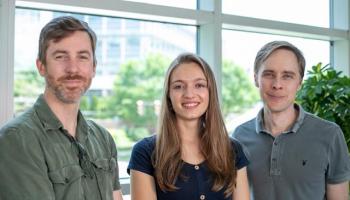New Funding Will Advance Promising Research on Neurodegenerative Disease
Incurable diseases like Alzheimer’s and Parkinson’s lead to debilitating conditions marked by the progressive degeneration of nerve cells, but new research is offering hope to the nearly 50 million people around the world who suffer from them. University of Virginia researchers recently identified a new cell type that could dramatically slow the progression of these diseases; this month, UVA’s Brain Institute, a cross-disciplinary research initiative based in the University’s College and Graduate School of Arts & Sciences, announced that it is funding the next phase of the research project.
According to Christopher Deppmann, a professor of biology and biomedical engineering at UVA, the key to future research breakthroughs may reside in cells known as Schwann cells. These glial cells that form the protective shell around axons may play a more active role in the breakdown of the nervous system than previously suspected, Deppmann said, and understanding how they function could lead to the development of therapies that could significantly extend the lives of those facing neurodegenerative diseases.
After a spinal-cord injury or a nerve injury, he explained, Schwann cells change into repair cells that contribute to the breakdown and removal of damaged axons, a normal function of the repair process. When the change is triggered by neurogenerative diseases like Alzheimer’s, that repair state, instead, results in further breakdown of axon. However, Deppmann and doctoral student Ekaterina Stepanova found that by inhibiting the function of the gene SARM1, they could prevent Schwann cells from moving into their repair state and lock them into the role of preventing further axon degeneration.
Essentially, Deppmann said, he and his team have discovered what is effectively a new type of cell and a new target for pharmaceuticals that could slow the breakdown of the nervous system in patients with neurodegenerative diseases.
“The implications of that are profound,” Deppmann said. “Now we have the ability to target these cells and develop drugs that lock Schwann cells into their protective state, provide metabolic support to the nervous system and keep axons alive longer.”
Translating Science into Medicine
While laboratory findings have been promising, a $50,000 grant from the UVA Brain Institute’s Transformative Neuroscience Pilot Grants seed funding program will allow Deppmann and his team to partner with UVA neurobiologist Sarah Kucenas, an expert in glial cells and development and neural regeneration, to expand the scope of the study. Working with Kucenas’s lab, they can test their findings in living organisms like zebrafish, a member of the minnow family with transparent skin that is widely used to test gene function.
According to Deppmann, the funding is essential to facilitating and funding this kind of collaboration between faculty members and student researchers with related research interests and complimentary skill sets and will make it possible to move the research into its translational phase, the next step in determining if it has the potential to impact the treatment of neurodegenerative diseases in humans.
Deppmann doesn’t see the research contributing to a cure for neurodegenerative diseases, but for those facing a long, slow decline in their quality of life, he said it could play a significant role in slowing the process.
“If we had a way to boost what’s going on in the Schwann cells to give people ten more years,” Deppmann said. “That’s big.”
Sarah Hunter-Chang, a doctoral student who will work with Kucenas on the second phase of the study, believes the study may have even broader implications.
“Researching this protection-associated Schwann cell state is a first step in figuring out what could be going on in a number of analogous cell types in the central nervous system,” Hunter-Chang said. “It gives us a jumping off point for lots of different translational research down the road.”
“This groundbreaking research by Professors Deppman and Kucenas, demonstrates the transformative potential of interdisciplinary collaboration in Arts & Sciences, said Christa Acampora, Buckner W. Clay Professor of Philosophy and dean of Arts & Sciences. “Their discovery advances our understanding of neurodegenerative diseases and underscores the vital role of translational research in addressing some of the most pressing challenges in human health. This is exactly the kind of bold, innovative work that defines our research community, and I am deeply proud of the faculty and students whose efforts are creating new possibilities for science and for humanity."
We’re here to answer your questions! Contact us today.







